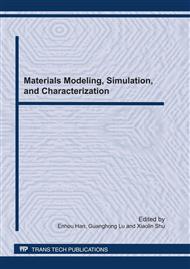p.43
p.49
p.58
p.64
p.69
p.74
p.85
p.91
p.95
Conductivity Mechanism of Asphalt Concrete with the PANI/PP Compound Conductive Fiber
Abstract:
Using SMA -16 (Stone Mastic Asphalt) non-continuous close-graded, a self-made polyaniline / PP (PANI / PP) compound conductive fiber was investigated as electric conduction phase, a new type of conductive asphalt concrete was prepared. The conducting performance tests shown that the conductivity of conductive asphalt concrete logarithmic changed from -12.67 to -6.67, increased by 6 orders of magnitude, and the percolation threshold was 1%. The scanning electron microscopy (SEM) shown that conductive fibers dispersed equably in asphalt concrete. Conduction mechanism of conductive asphalt concrete can be described as "an island - network" model and with the fiber fraction increased, the distribution of the conductive fiber turned from "isolated island" model to "conductive network chain" ,and at the same time the asphalt concrete changed from insulating to conducting accordingly. According to classical percolation theory, a filling factor F and network factor n was introduced, so that determined the meaning and value of the parameters, and established the electrical conductivity of conductive asphalt concrete theoretical formula. The theoretical results were in good agreement with the measured values.
Info:
Periodical:
Pages:
69-73
Citation:
Online since:
June 2011
Authors:
Price:
Сopyright:
© 2011 Trans Tech Publications Ltd. All Rights Reserved
Share:
Citation:


